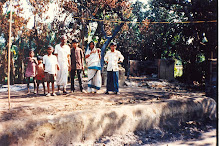Dawn March 7, 2017
·
For someone who knows
that such spaces are shrinking, the sight is a poignant reminder that all is
not lost.
The Indus is a mainstay of the Indian
civilisation. For the people of Sindh especially, its mythical status
penetrates each and every aspect of Sindhi life. The mention of River Indus,
or Sindhu, goes as far back as we can go in recorded history.
K.R. Malkani, a Sindhi
Hindu who had to leave his homeland during the mayhem of Partition, notes in
his book The Sindh Story:
In the beginning was
the word. The first recorded word was the Veda. And Veda is just ecstatic about
Sindhu, the cradle of Indian civilisation:
"Sindhu in might
surpasses all the streams that flow,
His roar is lifted upto heaven above the earth."
His roar is lifted upto heaven above the earth."
It is on the banks of
this mighty river that rishis and sages have spent endless
time contemplating the secrets of life and the universe.
Gradually, a cult of
river worship developed in some of the areas where the Indus flows. The
devotees personified their beliefs: Muslims would call him Khawaja Khizar,
Zinda Pir, and Sheikh Tahir, while Hindus would evoke him by the names like
Uderolal, Amar Lal, Uday Chand, and Jhulay Lal.
The people who follow
the cult of river Indus are called Daryapanthis and their main centre is at
Uderolal city, some 30km away from Hyderabad. The axis of the city is the
shrine-temple complex; wherever you may go, it forms a skyline and reassuringly
looms over the horizon. It embodies the spirit of Sindhudesh: the
sharing of everything that is sacred, be it a Sufi shrine, a Sikh gurdwara,
a Hindu temple, or a river deity.
The shrine complex at
Uderolal.
The principle ritual
is Chaiti Chand, which is both the birthday of Jhulay Lal and the
celebration of the Hindu New Year. Chait is the first month of
the Hindu calendar.
It sets in when the
winter has gone and spring has also come to an end but the hot, gusty winds
have not yet arrived. It is the time when wheat is harvested and fields are
being prepared for cotton or paddy crop in the south of Sindh.
Even though most of
Sindh's Hindus have migrated to India, Chaiti Chand is still
celebrated with religious fervour and a growing spirit of community. In fact,
after Partition, when Sindhis in India became a de-territorialised community,
Sindhi singer Ram Panjwani tried to bind them together in a sense of Sindhiyyat by
projecting the image of Uderolal as the patron saint or Ishtdev of
Sindhi Hindus.
A candle is lit inside
a room near the shrine.
The main rituals
commence in the evening and a stage is set for people to participate. The mela starts
with jyot jagayan, or lighting the sacred lamp.
The proceedings
continue with a pooja just before sunset, performed at the
sacred well of Balanbho sahib. Its water is believed to have
healing properties. After the prayer, chhandois performed in which
the water is sprinkled on the face. It is supposed to enlighten the spirit.
An integral part of
the mela is the behrano parwan karan, or floating
the behrano. Behranois a huge brass plate that is
decorated with flour, sweets, dried fruits, lamps, and rose petals. It is an
offering to the river and the Daryapanthis believe that fish and other aquatic
organisms eat the behrano and bestow blessings upon the
devotees.
The Uderolal complex
at night.
People bring the behrano to
Uderolal from various cities like Mirpurkhas, Shahdadapur, Sanghar, Nawabshah,
Sakrand and others. Traditionally, the behrano was floated
into the Indus, but now it is offered to any water body or canal because
whatever water there is in Sindh, it comes from the Indus.
Another ritual that
takes place during the mela is called pallao payan.
It is when devotees hold the hems of their shirts or dupattas and
pray to Uderolal to solve their problems and deliver them from the ordeals of
the world.
The proceedings end
with the chhej dance performed by energetic men wielding dandia.
The swaying movements resemble the waves of the Indus. The chhej starts
with a low rhythm and gradually moves to a frantic pace.
Jhulay Lal statue
inside the Darya Lal temple in Karachi.
As time passes, the
air gets thick with the fragrance of rose petals and incense, and the men
passionately chant:
Ayo ayo, jhulay lal
Jeko chawando jhulay lal, tehnja theenda bera paar
Jeko chawando jhulay lal, tehnja theenda bera paar
Jhulay Lal has arrived
One who would say Jhulay Lal's name, his boat will safely reach the shores
One who would say Jhulay Lal's name, his boat will safely reach the shores
It is followed
by Jiay jhulay lal chants from the crowd.
For someone who knows
that spaces for such activities are shrinking, the sight is at once
exhilarating and a poignant reminder that perhaps all is not lost – at least
not yet.
People offering their
respects at the Udero Lal Dargah.
The shrine complex at
sunset.
All photos are by the
author.
What is the most grand
festival or place of religious significance that you have visited? What did it
teach you? Share it with us at blog@dawn.com







No comments:
Post a Comment